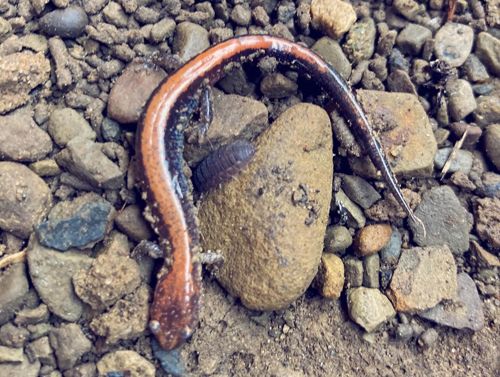Red-backed Salamander (and a pill bug/rolly polly)
Scientific Name: Plethodon cinereus (salamander) and Armadillidium vulgare (pill bug)
Order & Family: Caudata, Plethodontidae (salamander) and Isopoda, Armadillidiidae (pill bug)
Size: Red-backed Salamander: 2.5 to 5 inches (6.4 to 12.7 cm) total length. Pill bug: 0.5 to 0.7 inches (1.3 to 1.8 cm) long.

Natural Habitat
The salamander is typically found in moist deciduous and coniferous forests under rocks, logs, and leaf litter. The pill bug lives in damp, dark places under rocks, logs, and decaying organic matter.
Diet & Feeding
Red-backed Salamander: Carnivorous, feeding on small invertebrates such as insects, mites, millipedes, and worms. Pill bug: Detritivorous, feeding on decaying plant and animal matter, fungi, and sometimes young plants.
Behavior Patterns
Red-backed Salamander: Terrestrial, nocturnal, and lungless, absorbing oxygen through its skin. It can autotomize its tail when threatened. Pill bug: Terrestrial crustacean that rolls into a ball (conglobates) when disturbed for defense. They are decomposers.
Risks & Benefits
Red-backed Salamander: No risks to humans; benefits the ecosystem by controlling invertebrate populations and serving as prey for larger animals. Pill bug: Generally harmless to humans; beneficial as decomposers, aiding in nutrient cycling and soil health. Can sometimes damage young plants in gardens if populations are high.
Identified on: 11/7/2025